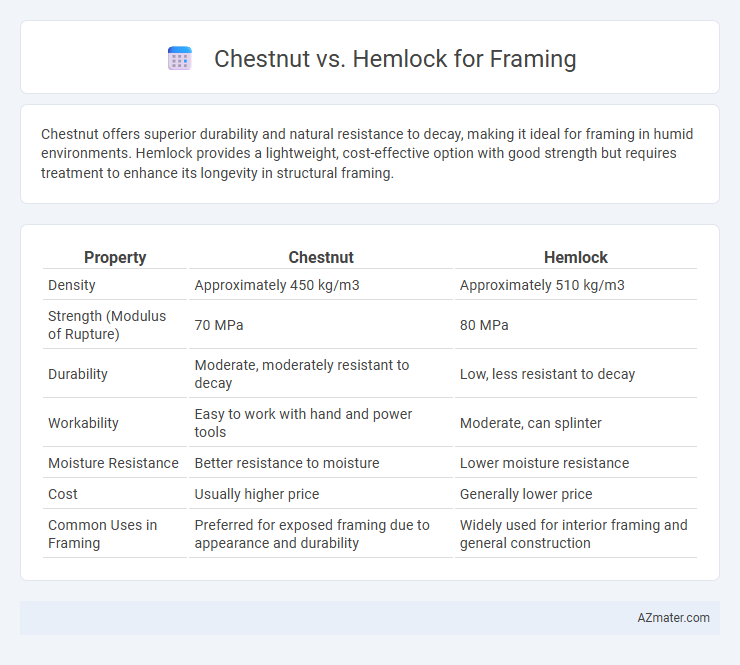Chestnut offers superior durability and natural resistance to decay, making it ideal for framing in humid environments. Hemlock provides a lightweight, cost-effective option with good strength but requires treatment to enhance its longevity in structural framing.
Table of Comparison
| Property | Chestnut | Hemlock |
|---|---|---|
| Density | Approximately 450 kg/m3 | Approximately 510 kg/m3 |
| Strength (Modulus of Rupture) | 70 MPa | 80 MPa |
| Durability | Moderate, moderately resistant to decay | Low, less resistant to decay |
| Workability | Easy to work with hand and power tools | Moderate, can splinter |
| Moisture Resistance | Better resistance to moisture | Lower moisture resistance |
| Cost | Usually higher price | Generally lower price |
| Common Uses in Framing | Preferred for exposed framing due to appearance and durability | Widely used for interior framing and general construction |
Introduction to Chestnut and Hemlock as Framing Woods
Chestnut and hemlock are popular framing woods known for their strength and workability in construction. American chestnut offers exceptional durability and resistance to decay, making it ideal for structural framing applications. Eastern hemlock provides a lightweight yet sturdy option with good dimensional stability, often favored for its cost-effectiveness and ease of handling in framing projects.
Historical Use and Popularity of Chestnut and Hemlock
American Chestnut was historically prized for framing due to its lightweight, rot-resistant properties, dominating construction before the chestnut blight in the early 20th century. Western Hemlock gained popularity as a framing material post-chestnut decline, valued for its abundance and consistent strength, making it a staple in North American lumber markets. Both species have contributed to framing, but chestnut's historical use is notable for its natural durability, while hemlock remains popular for its economic availability and workability.
Physical Characteristics: Density, Grain, and Appearance
Chestnut wood typically has a density of around 430 kg/m3, offering moderate strength with a coarse, straight grain that gives a rustic, slightly textured appearance ideal for traditional framing. Hemlock, denser at approximately 500 kg/m3, features a fine, even grain and a pale reddish-brown color that provides a smooth, uniform look suitable for structural framing where a clean finish is desired. The combination of chestnut's distinctive grain pattern and lighter density contrasts with hemlock's consistent texture and higher density, influencing choices based on aesthetic preference and load-bearing requirements.
Strength and Structural Performance Comparison
Chestnut offers superior tensile strength and natural resistance to splitting compared to hemlock, making it highly suitable for framing that demands durability and stability. Hemlock provides moderate strength with good stiffness but is more prone to shrinkage and warping under load, affecting long-term structural performance. When prioritizing load-bearing capacity and resilience, chestnut outperforms hemlock, ensuring enhanced framing integrity in construction projects.
Durability and Resistance to Decay
Chestnut wood offers excellent durability and superior resistance to decay due to its natural tannins, making it ideal for long-lasting framing projects. Hemlock, while moderately durable, is more susceptible to fungal decay and insect damage if not properly treated, reducing its lifespan in framing applications. Choosing chestnut for framing ensures enhanced structure integrity and minimal maintenance in moisture-prone environments.
Workability and Ease of Construction
Chestnut offers high workability due to its straight grain and moderate hardness, making it easy to saw, nail, and shape for framing applications. Hemlock, while also workable, tends to be slightly harder and contains more knots, which can complicate cutting and fastening during construction. Choosing chestnut reduces labor time and effort on-site, improving overall ease of construction in framing projects.
Cost and Availability in the Market
Chestnut wood is generally more expensive and less readily available for framing due to its limited supply and high demand for specialty woodworking projects. Hemlock offers a more cost-effective option with widespread availability, making it a popular choice for construction and framing purposes. Market trends indicate consistently higher prices for chestnut compared to the more abundant and affordable hemlock lumber.
Environmental Impact and Sustainability
Chestnut wood offers a more environmentally sustainable option for framing due to its faster growth rate and natural resistance to decay, reducing the need for chemical treatments compared to hemlock. Hemlock's slower growth and higher susceptibility to pests often lead to increased use of preservatives, which can contribute to environmental pollution. Choosing chestnut framing supports sustainable forestry practices by promoting renewable resources and lowering the carbon footprint associated with construction materials.
Best Applications for Chestnut vs Hemlock in Framing
American Chestnut, known for its high strength-to-weight ratio and natural resistance to decay, is ideal for framing applications requiring durability and long-lasting structural integrity, especially in outdoor or moisture-prone environments. Eastern Hemlock offers a more cost-effective and readily available option with good dimensional stability, making it suitable for interior framing where ease of machining and moderate strength are sufficient. For heavy load-bearing frameworks and projects emphasizing longevity, Chestnut outperforms Hemlock, which excels in standard residential framing due to its uniform grain and ease of handling.
Conclusion: Choosing the Right Wood for Your Framing Project
Chestnut offers excellent strength and natural resistance to decay, making it a durable option for long-lasting framing projects, while hemlock provides a more cost-effective and lightweight solution with good workability. Selecting the right wood depends on balancing budget constraints with structural requirements and environmental conditions. For projects demanding high durability and rot resistance, chestnut is preferable; for faster builds and lower costs, hemlock is ideal.

Infographic: Chestnut vs Hemlock for Framing
 azmater.com
azmater.com